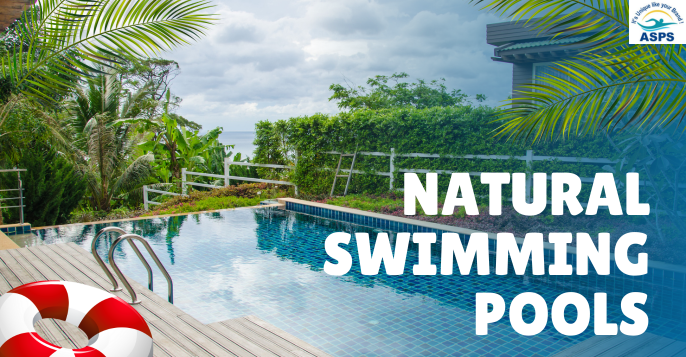In recent years, natural swimming pools, once refreshing and environmentally friendly alternatives to traditional chemically-treated pools, have gained popularity. Natural pools are highly sustainable, as they blend harmoniously with nature, taking on the appearance of a garden pond while delivering the functionality of a swimming pool. If you think you might want one, this guide takes you through the benefits, design considerations, and maintenance needs to help you create a natural oasis right in your own backyard.
Why Natural Swimming Pools?
There’s a good reason why people love natural swimming pools: they are designed to be very eco-friendly. Unlike conventional pools, where chlorine and other chemicals are used for water cleanliness, natural swimming pools use biological means of keeping the water clean. This can lead to a setting where the swimmer feels secure and it’s less harmful to the ecological surrounding.
Benefits of Natural Pools
- Chemical-Free Water: Natural pools don’t use harsh chemicals, making them healthier for both swimmers and the environment.
- Biodiverse Ecosystem: The plants and microorganisms create a balanced ecosystem, supporting aquatic life and purifying the water.
- Lower Maintenance Costs: While they need regular maintenance, natural pools avoid the cost of chemicals over the long term.
- Natural Beauty: These pools enhance the aesthetics of your property, creating a calming, spa-like environment.
- Year-Round Interest: While swim-friendly for part of the year, natural pools serve as attractive ornamental ponds in colder seasons.
Key Design Elements of a Natural Swimming Pool

Natural swimming pools need to be designed with a clear vision. Below are the key design elements.
1. The Swimming Area
This is the main space to swim and relax, designed to accommodate a specific number of swimmers for an optimal experience. Depth is another crucial factor, as natural pools often have deeper sections to keep the water cooler and balanced.
- Recommended Depth: Ideally 1.5 to 2.5 meters for good swimming. Deeper areas help stabilize temperature and inhibit algae overgrowth.
- Materials and Finishes: Smooth, non-porous finishes are easier to clean and limit algae, while natural finishes provide an earthy visual integration with the surroundings.
Regeneration Zone
A fundamental feature of natural pools is the plant zone or regeneration zone—the area where water passes through plants and beneficial microorganisms to filter and maintain clarity.
- Aquatic Plants: Choose plants like water lilies, reeds, and water hyacinths adapted to your climate. Native plants support local biodiversity.
- Filtration Functionality: Plants, along with substrates like gravel, filter the water as microorganisms break down organic matter.
- Placement and Maintenance: To keep filtration effective, regularly cut back plants and remove debris to avoid bacterial build-up.
2. Water Circulation and Filtration System
The quality of water in a natural pool depends on a good circulation system. This process is entirely biological, relying on plants and bacteria instead of chemicals.
- Biological Filters: Common methods include moving bed filters and trickling filters that ensure water cycles through the plant zone, keeping it clean.
- pH Balance: Maintain a slightly alkaline pH of about 8.0-8.6. Regularly monitor it as changes can affect plants and bacteria.
- Algae Control: Algae are a natural part of the ecosystem. Good water circulation and correct pH help control algae growth without scrubbing, which can release spores into the water.
Variations of Natural Swimming Pools
Select from several types of natural pools depending on your needs and budget:
- Non-Technified Natural Pool: Relies solely on natural processes with minimal equipment. This is low-maintenance but requires time to balance the ecosystem.
- Natural Pool with Recirculation: A pump recirculates water through the filter, adding clarity and reducing the footprint of the regeneration zone.
- Fully Technified Natural Pool: Includes additional systems like skimmers and algae scrubbers for crystal-clear water year-round, though it has higher upfront costs.
Maintenance Tips for Natural Pools
While generally lower-maintenance than traditional pools, natural pools still need routine care to keep the ecosystem balanced.
- Ecological swimming Pool Maintenance: Clean the biological filter every six months. Avoid chemicals; use safe alternatives like diluted hydrogen peroxide for algae control.
- Monitor Water Parameters: Keep pH between 8.0-8.6 and occasionally check phosphorus levels to prevent algae growth.
- Control Debris: Use a skimmer or manually clean debris to prevent decaying organic material from disrupting the water balance.
- Winter Care: Depending on climate, bring some plants indoors to avoid freezing. Leave minimal plant material to maintain bacterial colonies over winter.
Garnishing Your Natural Pools
Creating a beautiful pool is only the beginning. Additions like walkways and seating can enhance the overall experience. Consider the following:
- Lighting: Use LED pool lights or submersible lights for a night ambiance that highlights the water’s clarity.
- Seating and Shade: Comfortable lounge chairs and shaded areas like pergolas blend seamlessly with the pool’s ambiance.
- Minimalist Landscaping: Native plants around the pool provide a natural look that supports local biodiversity.
Conclusion
A natural swimming pool offers a sustainable and beautiful option for homeowners looking to create an eco-friendly sanctuary. With a thoughtful design, careful plant selection, and regular maintenance, a natural pool can provide a refreshing and healthy swimming experience while enhancing your property year-round. Whether swimming or simply enjoying the view, your natural sanctuary awaits!



